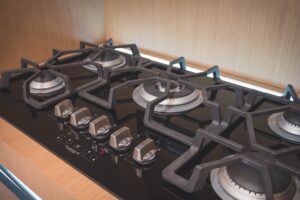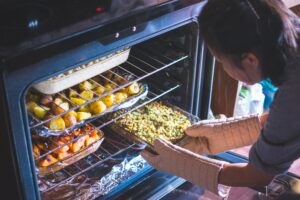Are you looking for an easier, more efficient way to cook your meals? As a long-time gas stove user, I can attest that mastering the art of cooking with this type of oven requires some skill and practice. Not only do you need to familiarise yourself with the various temperature settings and burner sizes, but also learn how to make sure each dish is cooked evenly and efficiently. With this helpful guide in hand, you will soon be on your way to confidently pulling off delicious homemade recipes using your gas stove!
Introducing the Benefits of Cooking with a Gas Stove
Cooking with a gas stove can revolutionise your entire culinary experience. Not only does it offer precise temperature control, but it also heats up food much faster than an electric stove, saving you valuable time in the kitchen. The instant flames make it easy to adjust the heat and maintain the desired temperature, allowing you to cook meals to perfection. Gas stoves are also much more energy-efficient than their electric counterparts, which means that you get to save money on your utility bills. And with all the amazing cookware that’s available today, there’s never been a better time to switch to a gas stove and take your cooking game to the next level.

How to Choose the Right Type of Gas Stove for Your Home
Finding the perfect gas stove for your home can be a daunting task with a seemingly endless array of options to choose from. With so many factors to consider, including size, power, and features, it can be overwhelming to decide which stove is the right fit for you. However, taking the time to research and educate yourself on the benefits of different types of gas stoves can help make the process easier. Whether you’re an avid chef or simply need a reliable stove for cooking daily meals, there is sure to be a gas stove that meets your unique needs and preferences.
Tips on Lighting a Gas Stove Safely and Efficiently
Cooking on a gas stove is a common practice, but do you know how to light it safely and efficiently? The first step is to make sure that your stove has been installed properly and is functioning correctly. Once that’s done, turn off all burners before attempting to light them. Use long-reach lighter or matches with long handles to prevent your hand from getting too close to the flames. Hold the lighter or match above the burner and turn on the gas. It’s important to monitor the flames carefully to ensure they are even and blue in colour. Finally, adjust the flames to the desired temperature for cooking. By following these simple tips, you can ensure a safe and efficient cooking experience on your gas stove.
Understanding the Different Heat Settings on a Gas Stove
Cooking on a gas stove is a popular choice for many home chefs. It provides instant heat and precise temperature control, but understanding the different heat settings can be overwhelming. It’s important to know that most gas stoves have four to six burners, each with different heat outputs. The burners are typically labeled with numbers or symbols indicating the level of heat they produce. It’s important to familiarise yourself with these labels and experiment to find the right heat level for each recipe. Whether you’re searing steak on high heat or simmering a soup on low heat, mastering the different heat settings on a gas stove can take your cooking skills to the next level.
Utilising Ovens, Grills, and Other Features of a Gas Stove
Cooking with a gas stove is a rewarding experience, and the different features it offers can help elevate your meals to the next level. Ovens, grills, and other features provide versatility in the kitchen and give you the freedom to create a variety of dishes. When it comes to baking, gas ovens allow for a consistent temperature and quick preheating, which can save you time and energy. Grilling is also made easy with a gas stove as you can control the heat levels and cook food to perfection. The other features like a broiler and a warming drawer are also handy tools that can make a significant difference in your cooking process. Whether it’s roasting a chicken or whipping up a batch of cookies, utilising the features on your gas stove can lead to some delicious results.

Cleaning and Maintenance of Your Gas Stove for Long-Term Use
Keeping your gas stove in tip-top shape is essential for maintaining its longevity and efficiency. Proper cleaning and maintenance are vital steps to ensure that your stove runs smoothly for years to come. To keep it running optimally, start by cleaning it thoroughly every time you use it. You should also inspect the burners and clean around them using a stiff-bristled brush to remove any stubborn dirt or grime. Additionally, regularly wiping down your stove’s surface with a damp cloth can help keep it looking new and prevent food stains from setting in. By following these simple tips, you can ensure that your gas stove provides you with delicious meals for many years of use.
Cooking with a gas stove has many benefits that are hard to come by in other kitchen setups. Gas stoves are powerful and energy-efficient, offering exact heat control and consistent performance. When selecting the right type of gas stove for your home, ensure that it can fit on your countertop or the intended area of installation. Gas stoves require proper handling and attention to safety precautions for lighting and understanding the different heat settings. Furthermore, appreciate the versatility of ovens, grills, and other features offered in most modern gas stoves. Finally, regular maintenance is necessary for long-term use of a gas stove so it remains clean and safe for years of cooking delicious meals!
